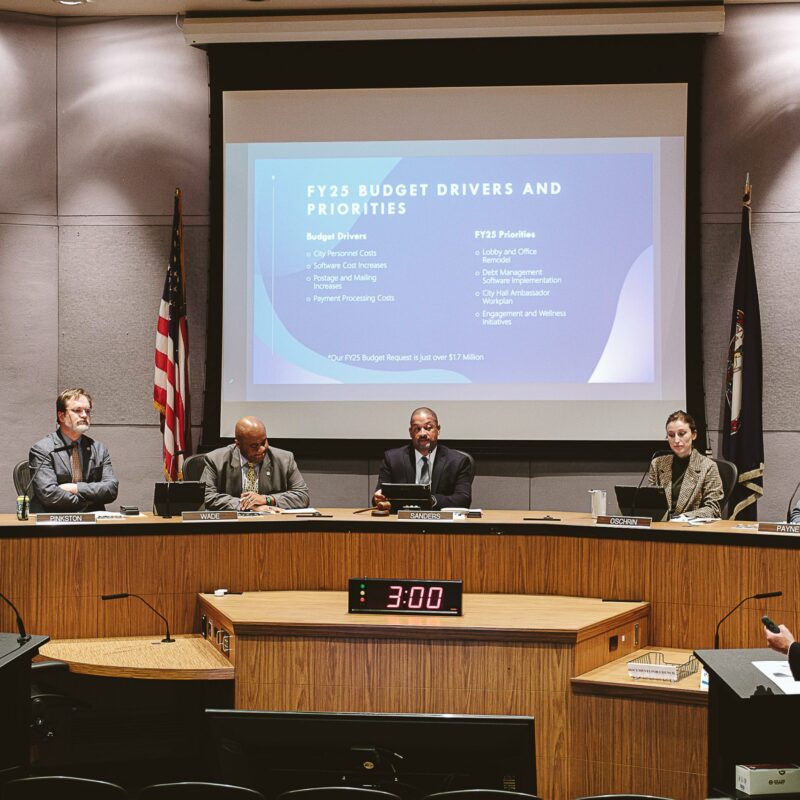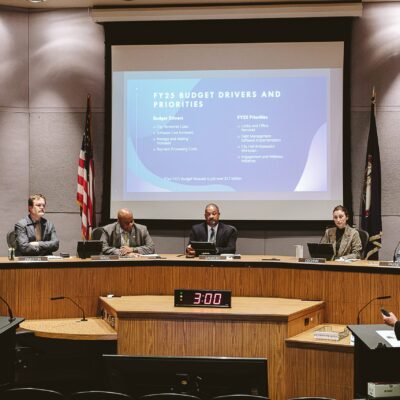“Standing room only,” says the woman that takes my ticket at the table outside of Four County Players, the 35-year-old community theater space just off of Route 33 in Barboursville. She gives me directions through the venue’s front door—red as an artery amidst the light yellow paint of the wooden building—to the bistro space and the auditorium, where Eli Cook’s record Miss Blues’ Child is already thumping a mix of Son House and Rage Against the Machine off of the walls.
 Eli Cook and his band riff on Hendrix at Four County Players. |
“Standing room only,” she says, and what I find nearly makes her comment seem a cruel joke: There are narrow lines of space that separate rows of seats, but little else. I nab a spot near the arm of a group of four chairs, but move a minute later when a large man asks if I’m saving them (I didn’t pay for a ticket, so I feel like I shouldn’t take up space).
“Moving further from the noise?” I ask the man, who leaves a group of seats closer to the stage and moves with three friends towards the back.
“Nah, wanted the leg room,” he says. “I like it loud.”
This man came from Lynchburg, he tells me, and has seen Eli Cook before, but this is the farthest he’s driven to see the 21-year-old blues blaster, and he tells me I’m in for a treat, “some real blues.” This man isn’t the first person that tries to sell me on Eli tonight: Everybody wants to be a part of a success story because everyone likes to feel their instincts validated, and so a handful of people approach me throughout the night to give me their mystic impressions of young Eli and how his music, his voice, just come from somewhere real, or authentic, or primal.
Tonight’s set is called “Hendrix Classic Works,” a night of songs by another distortion-loving blues man that made a name for himself by upstaging Cream in concert and laying down the definitive version of Bob Dylan’s “All Along the Watchtower.” No one accuses Jimi Hendrix of pop music apostasy for his reverb-and-distortion take on the blues or on one of Dylan’s classic cuts because his combination of youth and uncanny control placed him immediately at the head of the class. It occurs to me that everyone is packed into the auditorium because they want to see that success again. When it comes to rock stardom, the pool is standing room only.
“Buckle up!” shouts the emcee from his spot on stage, as I wedge myself between a couple in their 40s and a young girl who sports a hair extension three times the length of her dyed black cut. “Ready to fly? It’s gonna be loud!”
The show’s mechanics are spectacular. The grumble of thunder and distorted voices resounds through the speakers and a mock lightning bolt gleams in white light across the black backdrop. The band takes the stage—a drummer with a whispy ponytail and facial hair, a hulking bassist that sports dark shades, a goatee and a resemblance to Judas Priest’s Rob Halford—and then the kid, Little Boy Blues, in a golden robe and snakeskin boots.
The first two songs are ragged and rough, Eli’s guitar swallowing the works like a mouth and Eric Yates’ bass line bucking like a rumbling gut, but by the third song—the cascading “Castles Made of Sand”—everything is in perfect working order. As the lyrics command, Eli lets the tenuous castles of guitar work fall into the sea in a flurry of eastern, sitar-like riffs to round out the number.
The set is heavy on lesser known Hendrix tunes; the band gets into “Who Knows?” next, Eli playing up one of his favorite tricks of the night, swinging his fricasseed Fender towards his amp to generate feedback then hammering the body of his guitar and the instrument’s fragile whammy bar at once, in some loose control of what sounds like a dust storm. Eli’s drummer, Jordan Marchini, hits his stride, his snare rolls coming in flurries that sound like sand falling on tin rooftops. The song segues beautifully into “Have You Ever Been Experienced?” courtesy of a digital delay pedal and a dusty march on a snare drum from Marchini. The whole set begins to take on the aural texture of flammable gauze.
“Angel” and “Manic Depression” rip, the last song shimmering in a long drum bridge and a strobing chord progression, and then Eli sees the audience into a 15-minute intermission with one of Hendrix’s 12-bar blues numbers (which I can’t place, but which the audience loves nonetheless). The band seems more assured during their second set, bassist Yates taking longer runs on his fills and Eli taking extended solos on a few more tracks; the young bluesman even kicks the set off with a teaser, “Sgt. Pepper’s Lonely Hearts Club Band,” which Hendrix played at the Isle of Wight in 1970.
Eli took an ill-advised stab at a few Hendrix songs on a 12-string acoustic towards the end of the night (“The Wind Cries Mary,” one of Jimi’s most delicate tunes, just sounded tinny and odd, while “Hey Joe” fared a bit better), but regained his footing during “Hey Baby,” punching up the introduction with a series of chords synchronized with Yates’ bass. For all of the hope placed on the young performer tonight, nothing breaks—not a star, not a speaker—save for a single string during “Voodoo Chile,” which Eli plucks from his guitar mid-song, earning a wounded animal’s shriek from his guitar, his prey, and then carries on without.





